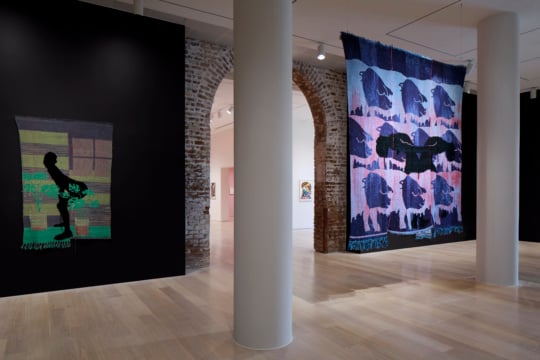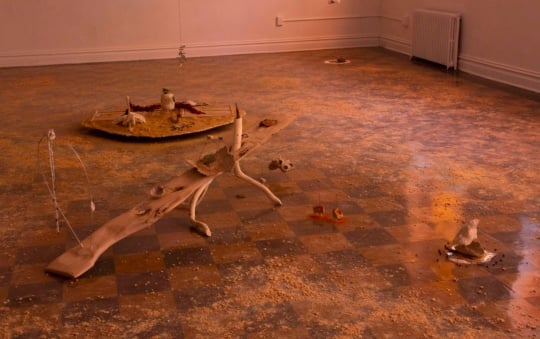
“When I Conjure These Memories,” a rare show of works by Romare Bearden, at Alan Avery Art Company through January 16, is the result of a collaboration between Alan Avery and art advisor Jerry Thomas, who bring together both well-known and under-appreciated styles from Bearden’s body of work. The exhibition features the artist’s signature collage work, as well as pieces that employ painting and printmaking. The works include scenes from the urban Northeast, the rural South, and the Caribbean, and highlight the vibrant black and African American experience in these areas. This body of work was produced late in the artist’s career — mostly in the 1970s and ’80s — giving them the wistful quality of images created from memory.
Drawn from the Romare Bearden Foundation collection, the 24 works on view represent five. distinct series: Pittsburgh, New York, Mecklenburg (the North Carolina county where the artist was born), Jazz, and the Caribbean series (Bearden and his wife lived part time in St. Maarten later in his career). The works show a sophisticated sense of subject matter and techniques. The portraits show more than simple faces; Bearden reveals details of environment and culture in these works. Look closely at the landscapes and you’ll find hidden figures living quietly in the artwork. Bearden painted with paper, and used collage to create impasto, masking, gestural abstraction, ombré, and other foundational techniques. What comes forth is a seamless, energetic style that is uniquely Romare Bearden.

The monotype prints are the most intriguing works for me. In this technique, the artist paints directly onto a nonabsorbent surface (in Bearden’s case, most likely glass), and the wet paint is pressed onto paper to produce a one-of-a-kind print. In the process of printing, the lines can get smudged, bubbles can form, and colors can bleed together. Bearden used these imperfections to his advantage, as they heighten the magic of the scenes he recreates.
One of the most popular images from the show, Blues at Night, encapsulates the best of monotype’s quirky imperfections. Bearden applied a field of dark green colors to his glass, and then created figures by removing paint. Streaks of white form the shapes of a piano player with his back to us, and a voluptuous woman perched on the piano singing along. In the upper right-hand corner, Bearden removed a circle of paint to give the effect of a full moon lighting the pair. Some color is added to give the female figure more detail—brown for her skin, yellow for her dress, and navy for her hair. The lines and colors of the female figure’s body blend into the form of the piano, showing her connection with the music. An uneven splotch above the open piano lid suggests that music is emanating from the instrument. A constellation of bubbles below the moon emulate a starlit night. You can almost feel the cool, smooth-toned blues coming from the print, and you can appreciate Bearden’s synthesis of music and art.

Two works from the Mecklenburg series highlight Bearden’s ability to blend different techniques into his painterly style. Mecklenburg Autumn: October – Toward Paw’s Creek features a foreshortened view into a wooded path; leaves line the ground, trees shoot up in the upper half of the canvas, and a high horizon line gives the effect of looking far into a rising landscape. The left side of the canvas is saturated with warm orange tones, while the right side has more green. This dynamic color composition creates a sense of change in the landscape over time rather than a static moment. Mecklenburg Autumn: September – Sky and Meadow brings figures to the landscape with a bearlike man walking through the forest; abstract shapes evocative of birds and deer peer down on him. In this work, Bearden masked the canvas to create negative-space trees, which he overpainted with wild colors to give the effect of dense, overgrown nature.

Pittsburgh Recollections, a long collage on fiberboard, was a maquette for a larger commission of a subway mural that tells the story of the Steel City. On the far left, a Native American presides over the spot where the Ohio River converges with the Allegheny and the Monongahela rivers. The left half of the painting shows elements of colonialism and the early United States, complete with steamships and ladies working at a loom. The right half of the painting repeats the same landscape, this time showing industrial steel production and contemporary arts and science education. Composed of 780 tiles and stretching 60 feet in length, the mural was installed in a subway station in 1984, and relocated in 2008-09 during construction of a new station; at the time, it was valued to be worth $15 million.

Another work in the exhibition, Black History (1979), features elements that Bearden used in a 1976 mural he painted on Martin Luther King Boulevard in downtown Atlanta. That work, like too many treasures in this city, has been demolished.
Matthew Terrell writes, photographs, and creates videos in the fine city of Atlanta. His work can be found regularly on the Huffington Post, where he covers such subjects as the queer history of the South, drag culture, and gay men’s health issues. He was a participant in Cycle 2 of BURNAWAY’s Art Writers Mentorship Program.




